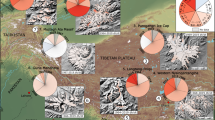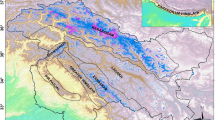Abstract
Assessments of the state of health of Hindu-Kush–Karakoram–Himalaya glaciers and their contribution to regional hydrology and global sea-level rise suffer from a severe lack of observations1. The globally averaged mass balance of glaciers and ice caps is negative1,2,3. An anomalous gain of mass has been suggested for the Karakoram glaciers2,4,5,6, but was not confirmed by recent estimates of mass balance. Furthermore, numerous glacier surges in the region that lead to changes in glacier length and velocity7,8,9,10,11 complicate the interpretation of the available observations. Here, we calculate the regional mass balance of glaciers in the central Karakoram between 1999 and 2008, based on the difference between two digital elevation models. We find a highly heterogeneous spatial pattern of changes in glacier elevation, which shows that ice thinning and ablation at high rates can occur on debris-covered glacier tongues. The regional mass balance is just positive at +0.11±0.22 m yr−1 water equivalent and in agreement with the observed reduction of river runoff that originates in this area12. Our measurements confirm an anomalous mass balance in the Karakoram region and indicate that the contribution of Karakoram glaciers to sea-level rise was −0.01 mm yr−1 for the period from 1999 to 2008, 0.05 mm yr−1 lower than suggested before13.
This is a preview of subscription content, access via your institution
Access options
Subscribe to this journal
Receive 12 print issues and online access
$259.00 per year
only $21.58 per issue
Buy this article
- Purchase on Springer Link
- Instant access to full article PDF
Prices may be subject to local taxes which are calculated during checkout



Similar content being viewed by others
References
Kaser, G., Cogley, J. G., Dyurgerov, M. B., Meier, M. F. & Ohmura, A. Mass balance of glaciers and ice caps: consensus estimates for 1961–2004. Geophys. Res. Lett. 33, L19501 (2006).
Zemp, M., Hoelzle, M. & Haeberli, W. Six decades of glacier mass-balance observations: A review of the worldwide monitoring network. Ann. Glaciol. 50 (50), 101–111 (2009).
Cogley, J. G. Geodetic and direct mass-balance measurements: Comparison and joint analysis. Ann. Glaciol. 50 (50), 96–100 (2009).
Cogley, J. G. Present and future states of Himalaya and Karakoram glaciers. Ann. Glaciol. 52 (59), 69–73 (2011).
Hewitt, K. The Karakoram anomaly? Glacier expansion and the ‘elevation effect’, Karakoram Himalaya. Mt. Res. Dev. 25, 332–340 (2005).
Scherler, D., Bookhagen, B. & Strecker, M. R. Spatially variable response of Himalayan glaciers to climate change affected by debris cover. Nature Geosci. 4, 156–159 (2011).
Hewitt, K. Tributary glacier surges: An exceptional concentration at Panmah Glacier, Karakoram Himalaya. J. Glaciol. 53, 181–188 (2007).
Barrand, N. E. & Murray, T. Multivariate controls on the incidence of glacier surging in the Karakoram Himalaya. Arct. Antarct. Alp. Res. 38, 489–498 (2006).
Copland, L. et al. Glacier velocities across the central Karakoram. Ann. Glaciol. 50 (52), 41–49 (2009).
Quincey, D. J. et al. Karakoram glacier surge dynamics. Geophys. Res. Lett. 38, L18504 (2011).
Copland, L. et al. Expanded and recently increased glacier surging in the Karakoram. Arct. Antarct. Alp. Res. 43, 503–516 (2011).
Fowler, H. J. & Archer, D. R. Conflicting signals of climatic change in the Upper Indus Basin. J. Clim. 19, 4276–4293 (2006).
Church, J. A. et al. Revisiting the Earth’s sea-level and energy budget from 1961 to 2008. Geophys. Res. Lett. 38, L18601 (2011).
Fujita, K. & Nuimura, T. Spatially heterogeneous wastage of Himalayan glaciers. Proc. Natl Acad. Sci. USA 108, 14011–14014 (2011).
Quincey, D. J. et al. Ice velocity and climate variations for Baltoro Glacier, Pakistan. J. Glaciol. 55, 1061–1071 (2009).
Hewitt, K. Glacier change, concentration, and elevation effects in the Karakoram Himalaya, Upper Indus Basin. Mt. Res. Dev. 31, 188–200 (2011).
Bader, H. Sorge’s law of densification of snow on high polar glaciers. J. Glaciol. 2, 319–323 (1954).
Mattson, L. E., Gardner, J. S. & Young, G. J. in Snow and Glacier Hydrology (ed. Young, G. J.) 289–296 (IAHS Publ. 218, 1993).
Sakai, A., Takeuchi, N., Fujita, K. & Nakawo, M. in Debris-Covered Glaciers (eds Nakawo, M., Raymond, C. F. & Fountain, A.) 119–130 (IAHS Publ. 264, 2000).
Berthier, E. et al. Remote sensing estimates of glacier mass balances in the Himachal Pradesh (Western Himalaya, India). Remote Sens. Environ. 108, 327–338 (2007).
Bhutiyani, M. R. Mass-balance studies on Siachen Glacier in the Nubra valley, Karakoram Himalaya, India. J. Glaciol. 45, 112–118 (1999).
Bolch, T., Pieczonka, T. & Benn, D. I. Multi-decadal mass loss of glaciers in the Everest area (Nepal Himalaya) derived from stereo imagery. Cryosphere 5, 349–358 (2011).
Azam, M. F. et al. From balance to imbalance: A shift in the dynamic behaviour of Chhota Shigri Glacier (Western Himalaya, India). J. Glaciol. 58, 315–324 (2012).
Heid, T. & Kääb, K. Worldwide widespread decadal-scale decrease of glaciers speed revealed using repeat optical satellite images. Cryosphere Discuss. 5, 3025–3051 (2011).
Tahir, A. A., Chevallier, P., Arnaud, Y. & Ahmad, B. Snow cover dynamics and hydrological regime of the Hunza River Basin, Karakoram Range, Nothern Pakistan. Hydrol. Earth Syst. Sci. 15, 2275–2290 (2011).
Archer, D. R. & Fowler, H. J. Spatial and temporal variations in precipitation in the Upper Indus Basin, global teleconnections and hydrological implications. Hydrol. Earth Syst. Sci. 8, 47–61 (2004).
Nuth, C. & Kääb, A. Co-registration and bias corrections of satellite elevation data sets for quantifying glacier thickness change. Cryosphere 5, 271–290 (2011).
Gardelle, J., Berthier, E. & Arnaud, Y. Impact of resolution and radar penetration on glacier elevation changes computed from DEM differencing. J. Glaciol. 58, 419–422 (2012).
Berthier, E., Arnaud, Y., Baratoux, D, Vincent, C. & Rémy, F. Recent rapid thinning of the ‘Mer de Glace’ glacier derived from satellite optical images. Geophys. Res. Lett. 31, L17401 (2004).
Wake, C.P. Glaciochemical investigations as a tool for determining the spatial and seasonal variation of snow accumulation in the central Karakoram, northern Pakistan. Ann. Glaciol. 13, 279–284 (1989).
Acknowledgements
J.G. acknowledges a PhD fellowship from the French Space Agency (CNES) and the French National Research Center (CNRS). E.B. acknowledges support from CNES through the TOSCA and ISIS proposal no. 397 and from the Programme National de Télédétection Spatiale. We thank the United States Geological Survey for allowing free access to their Landsat archive, CIAT for SRTM C-band data and DLR for SRTM X-band data. We thank A. Kääb for his comments on an earlier version of the manuscript and G. Cogley for a constructive review.
Author information
Authors and Affiliations
Contributions
J.G. led the development of this study, carried out all DEM analysis and led the writing of the manuscript. Y.A. and E.B. initiated the study and contributed to the development of the methodology, discussion of results and the writing of the manuscript.
Corresponding author
Ethics declarations
Competing interests
The authors declare no competing financial interests.
Supplementary information
Supplementary Information
Supplementary Information (PDF 2193 kb)
Rights and permissions
About this article
Cite this article
Gardelle, J., Berthier, E. & Arnaud, Y. Slight mass gain of Karakoram glaciers in the early twenty-first century. Nature Geosci 5, 322–325 (2012). https://doi.org/10.1038/ngeo1450
Received:
Accepted:
Published:
Issue Date:
DOI: https://doi.org/10.1038/ngeo1450
This article is cited by
-
Assessment and modelling of hydro-sedimentological flows of the eastern river Dhauliganga, north-western Himalaya, India
Natural Hazards (2024)
-
Climatic and topographic controls on glacial changes (1973–2020) in Shigar Basin, Central Karakoram, Northern Pakistan
Environmental Science and Pollution Research (2023)
-
Comparison of energy and mass balance characteristics between two glaciers in adjacent basins in the Qilian Mountains
Climate Dynamics (2023)
-
The rapid vegetation line shift in response to glacial dynamics and climate variability in Himalaya between 2000 and 2014
Environmental Monitoring and Assessment (2023)
-
Spatio-temporal snow cover change in the early twenty-first century using improved MODIS dataset: a case study of District Hunza, Pakistan
Climate Dynamics (2023)



